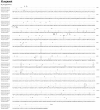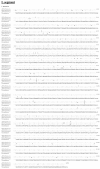The full genome sequence of three strains of Jamestown Canyon virus and their pathogenesis in mice or monkeys
- PMID: 21435230
- PMCID: PMC3076256
- DOI: 10.1186/1743-422X-8-136
The full genome sequence of three strains of Jamestown Canyon virus and their pathogenesis in mice or monkeys
Abstract
Background: Jamestown Canyon virus (JCV), family Bunyaviridae, is a mosquito-borne pathogen endemic in the United States and Canada that can cause encephalitis in humans and is considered an emerging threat to public health. The virus is genetically similar to Inkoo virus circulating in Europe, suggesting that much of the northern hemisphere contains JCV or similar variants.
Results: We have completed the sequence of three isolates of JCV collected in geographically diverse locations over a 57 year time span. The nucleotide identity for the three strains is 90, 83, and 85% for the S, M, and L segments respectively whereas the percent identify for the predicted amino acid sequences of the N, NSS, M poly, GN, NSM, GC, and L proteins was 97, 91, 94, 98, 91, 94, and 97%, respectively. In Swiss Webster mice, each JCV isolate exhibits low neuroinvasiveness but high infectivity. Two of the three JCV isolates were highly neurovirulent after IC inoculation whereas one isolate, JCV/03/CT, exhibited low neurovirulence. In rhesus monkeys, JCV infection is accompanied by a low-titered viremia, lack of clinical disease, but a robust neutralizing antibody response.
Conclusions: The first complete sequence of JCV is reported for three separate isolates, and a relatively high level of amino acid sequence conservation was observed even for viruses isolated 57 years apart indicating that the virus is in relative evolutionary stasis. JCV is highly infectious for mice and monkeys, and these animals, especially mice, represent useful experimental hosts for further study.
Figures





References
-
- Walters LL, Tirrell SJ, Shope RE. Seroepidemiology of California and Bunyamwera serogroup (Bunyaviridae) virus infections in native populations of Alaska. Am J Trop Med Hyg. 1999;60:806–821. - PubMed
-
- Sather GE, Hammon WM. Antigenic patterns within the California encephalitis virus group. Am J Trop Med Hyg. 1967;16:548–557. - PubMed
-
- DeFoliart GR, Anslow RO, Hanson RP, Morris CD, Papadopoulos O, Sather GE. Isolation of Jamestown Canyon serotype of California encephalitis virus from naturally infected Aedes mosquitoes and tabanids. Am J Trop Med Hyg. 1969;18:440–447. - PubMed
-
- Cheng LL, Rodas JD, Schultz KT, Christensen BM, Yuill TM, Israel BA. Potential for evolution of California serogroup bunyaviruses by genome reassortment in Aedes albopictus. Am J Trop Med Hyg. 1999;60:430–438. - PubMed
-
- Andreadis TG, Anderson JF, Armstrong PM, Main AJ. Isolation of Jamestown Canyon Virus (Bunyaviridae: Orthobunyavirus) from Field-Collected Mosquitoes (Diptera: Culicidae) in Connecticut, USA: A Ten-Year Analysis, 1997-2006. Vector Borne Zoonotic Diseases. 2008;8:175–188. doi: 10.1089/vbz.2007.0169. - DOI - PubMed
Publication types
MeSH terms
Substances
Grants and funding
LinkOut - more resources
Full Text Sources
Molecular Biology Databases
Miscellaneous

